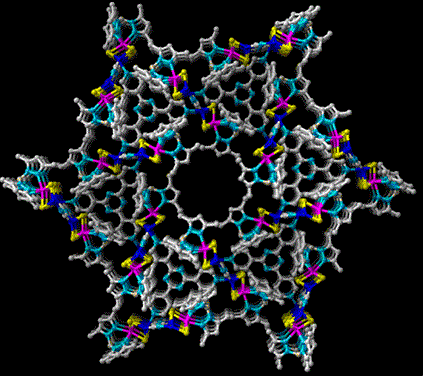†‡§, †, ∥, ∥, *†(张文华), and *†‡(郎建平)
† State and Local Joint Engineering Laboratory for Novel Functional Polymeric Materials, College of Chemistry, Chemical Engineering and Materials Science, Soochow University, Suzhou 215123, P. R. China
‡ State Key Laboratory of Organometallic Chemistry, Shanghai Institute of Organic Chemistry, Chinese Academy of Sciences, Shanghai 200032, P. R. China
§ College of Chemistry and Chemical Engineering, Nantong University, Nantong 226019, P. R. China
∥ School of Physical Science and Technology, Soochow University, Suzhou 215006, P. R. China
Cryst. Growth Des., 2016, 16 (6), pp 3206–3214
We have prepared a family of [WS3Cu2]-based coordination polymers with a rare μ-N type coordination by a simple one-pot assembly of [Et4N][Tp*WS3] (1) with CuCN in the presence of pyridine (py), 4,4′-bipyridine (bipy), 1,2-bis(4-pyridyl)ethane (bpea), and 2,4,6-tri(4-pyridyl)-1,3,5-triazine (tpt) at room temperature. The resulting coordination polymers [Tp*WS3Cu2(CN)(μ-py)]2·py (2·py), [Tp*WS3Cu2(CN)2Cu(μ-py)2]2·3py (3·3py), [Et4N][{Tp*WS3(CuCN)2Cu}2(CN)(μ4-bipy)] (4), [Tp*WS3Cu2(CN)(μ4-bpea)0.5]2·CH2Cl2 (5·CH2Cl2), and [Tp*WS3Cu2(CN)(μ6-tpt)1/3]2 (6) share a butterfly-shaped [Tp*WS3Cu2] motif with sizable concave to accommodate pyridyl ligands. The approximate mirror symmetry of the motif also induces the orthogonal coalignment of the pyridyl ligands, reinforcing a unique μ-type association with the Cu centers of the cluster skeleton. Such a coordination mode, though scarce in general coordination chemistry, is universal in our series with good ligand tolerance including ligand size and symmetry. In addition, each butterfly-shaped [Tp*WS3Cu2] motif is linked by CN (2), Cu(CN)2 (3), Cu2(CN)5/μ4-bipy (4), CN/μ4-bpea (5), and CN/μ6-tpt (6) to yield diverse polydimensional structures showing one-dimensional zigzag chains (2 and 3), two-dimensional networks (4 and 5), and a three-dimensional net (6). The third-order nonlinear optical (NLO) property of 2–6 in DMF measured using a Z-scan technique at 532 nm demonstrated that 2–6 have a reverse saturable absorption and self-focusing effects with the hyperpolarizability γ values in the range of 6.32 × 10–30 esu to 9.82 × 10–30 esu. Such values are remarkably larger than that of their precursor complex 1 (1.07 × 10–32 esu). The results provide an interesting insight into how the μ-type coordination mode of N-donor ligands affects the self-assembly of the [Tp*WS3Cu2]-supported coordination polymers and their structural topologies, as well as their third-order NLO performances.

链接:http://pubs.acs.org/doi/abs/10.1021/acs.cgd.6b00115